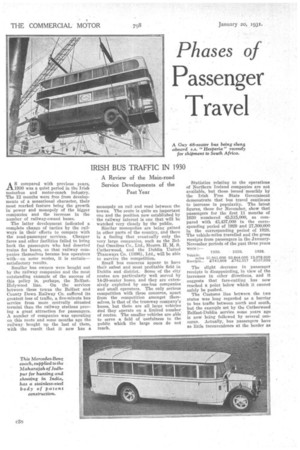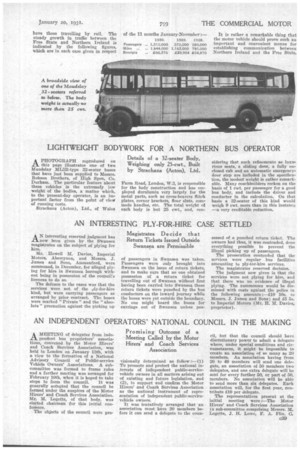Phases of
Page 60

Page 61

If you've noticed an error in this article please click here to report it so we can fix it.
Passenger Travel
AS compared with previous years, 1930 was a quiet period in the Irish motorbus and motor-coach industry. The 12 months were free from developments of a sensational character, their most marked feature being the growth in: power and monopoly of the bigger companies and the increase in the number of railway-owned buses.
The latter development indicated a complete change of tactics by the railways in their efforts to compete with the road-passenger services. Cheaper fares and other facilities failed to bring back the passengers who had deserted trains for buses, so that railway companies themselves became bus operators with—on some routes, it is certain—. satisfactory results.
Smaller bus owners were bought out by the railway companies and the most outstanding example of the success of this policy is perhaps, the Belfast-. Holywood line. On the services between these towns the Belfast and County Down Railway Co. suffered its greatest loss of traffic, a five-minute bus service from more centrally situated termini than the railway stations proving a great attraction for passengers. A number of companies was operating on this route and some months ago the railway bought up the last of them, with the result that it now has a
monopoly on rail and road between the towns. The route is quite an important one and the position now established by the railway interest is one that will be watched very closely by the public.
Similar monopolies are being gained in other parts of the country, and there is a feeling that eventually only the very large companies, such as the Belfast Omnibus Co., Ltd., Messrs. H. M. S. Catherwood, and the Dublin United Tramways Co. (1896), Ltd., will be able to survive the competition.
Small bus concerns appear to have their safest and most profitable field in Dublin and district. Some of the city routes are particularly well served by 14-20-seater buses, and they are extensively exploited by one-bus companies and small operators. The only serious competition with these concerns, apart from the competition amongst themselves, is that of the tramway company's buses, but these are all large vehicles and they operate on a limited number of routes. The smaller vehicles are able to serve a field of usefulness to the public which the large ones do not reach. Statistics relating to the operations of Northern Ireland companies are not available, but those issued 'monthly by the Irish Pree State Government demonstrate that bus travel continues to increase in popularity. •The latest figures, those for November, show that passengers for the first 11 months of 1930 numbered 45,515,000, as compared with 43,437,000 in the corresponding period of 1929 and 27,300,000 in the corresponding period of 1928. The vehicle-miles travelled and the gross receipts from passengers in the JanuaryNovember periods of the past three years were :—
The slight decrease in passenger receipts is disappointing, in view of the increases in other directions, and it suggests that fare-cutting has now reached a point below which it cannot safely be pushed.
The Customs line between the two states was long regarded as a barrie,r to bus traffic between north and south, but the example set by the Catherwood Belfast-Dublin service some years ago is now being followed by several concerns. Actually, bus passengers have as little inconvenience at the border as have those travelling by rail. The steady growth in traffic between the Free State and Northern Ireland is indicated by the following figures, which are in each case given in respect
APHOTOGRAPH reproduced on thin page illustrates one of two Maudslay ML3B-type 32-seater buses that have just been supplied to Messrs. Robson Brothers, of High Span, Co. Durham. The particular feature about these vehicles is the extremely low weight of the bodies, a matter which, to the present-day operator, is an important factor from the point of view of running costs.
Strachans (Acton), Ltd., of Wales Farm Road, London, W.3, is responsible for the body construction and has employed duralumin very largely for the metal parts, such as cross-bearers flitch plates, corner brackets, floor slats, commode handles, etc. The total weight of each body is but 25 cwt., and, con It is rather a remarkable thing that the motor vehicle should prove such an important and convenient means for establishing communication between Northern Ireland and ths Free State.
sidering that such refinements as luxurious seats, a sliding door, a fully enclosed cab and an automatic emergencydoor step are included in the specification, the modest weight is rather remarkable. Many coachbuilders reckon on the basis of 1 cwt. per passenger for a good bus body, and include the driver and conductor in the calculation. On that basis a 82-seater of this kind would weigh 9 cwt. more than in this instanc:3 —a very creditable reduction,












































































































